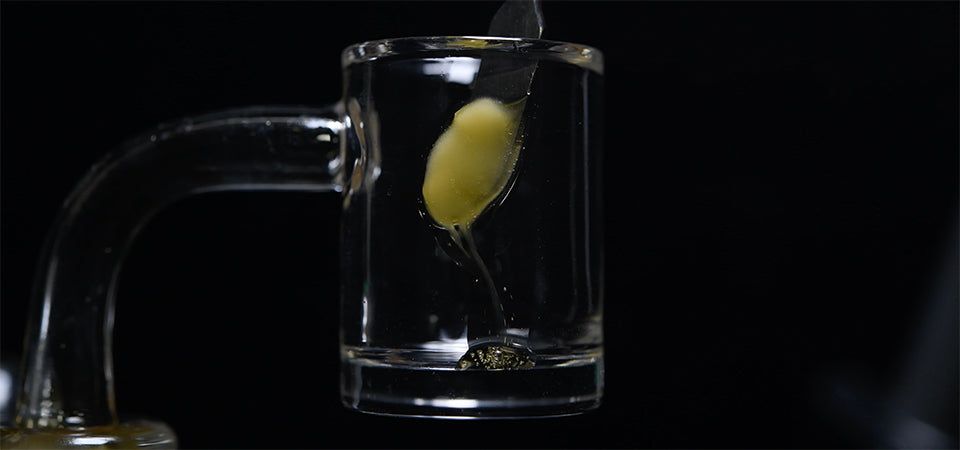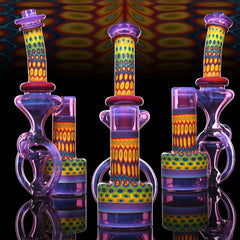How to Dab for Beginners

Dabs are the name of the game when it comes to solventless extraction. The highest quality dry sift, bubble hash, and rosin are ultimately dabbed because it's the best way to experience their exquisite aromas and flavors.
If you've never dabbed before, there are several things you need to know to get the best out of the experience and your solventless concentrates. Don't fret, however—perfecting the art of dabbing is well worth it!
What Is a Dab?

A dab is a tiny amount of cannabis concentrate that is placed on a heated dab nail, vaporized, and the cannabis vapor is then inhaled. It's a bit like inhaling cannabis smoke through a bong (as both use water) except that a dab rig is used to vaporize concentrates whereas a bong is used to smoke or combust dry herb.
The cannabis concentrates that can be dabbed include both solvent-based products like BHO and solventless products like rosin and piatella. Very pure dry sift can also be dabbed. However, it takes a significant amount of work to purify dry sift to this point.
Benefits of Dabbing
Dabbing offers four major advantages over smoking a joint:
- Taste: The THC concentrates that are dabbed contain the resin from the trichomes and a lot less plant material than whole bud. This means that the flavor is very rich and far less "green." It's a bit like eating a delicious tomato chutney rather than eating the entire tomato plant.
- Potency: THC concentrates typically contain around 50-80% THC (and sometimes far more) whereas cannabis flower typically contains 15-25% THC. This means that the effects are more intense than you would usually expect from smoking dry flower.
- Smoothness: The vapor produced in the dab nail passes through water before it is inhaled (just as with a bong). Using any kind of water pipe results in smoother hits compared to smoking a joint.
- Fewer carcinogens: Dabbing produces vapor rather than smoke and doesn't involve additional materials (like rolling paper). So it automatically produces fewer toxins and carcinogens. However, dabbing at temperatures between 600°F and 1000°F has been shown to produce methacrolein and benzene which are toxic to breathe in—so it's essential to get the temperature right.
Drawbacks of Dabbing
Dabbing also has a few drawbacks that you need to keep in mind:
- Learning curve: Using a dab rig requires a fair bit of equipment and it takes practice to achieve the best temperature for vaporization. However, it's well worth it (in our opinion) to enjoy the benefits listed above.
- Side-effects of THC: Dab vapor is extremely high in THC and it's easy to overdo it. Symptoms of overconsumption include a racing heart, panic attacks, paranoia, hallucinations, and uncontrollable shaking. To prevent this, take it very slowly, start with a lower temperature (hotter temperature dabs can contribute to these side effects for those new to dabbing), and dab only minute amounts of concentrate at one time (the size of half a grain of rice is ideal). If you overdo it, just wait it out and try a smaller serve and a lower temperature next time.
- Risk of burns: The blow torch and nail get extremely hot and can burn you if you're not careful. Be sure to use equipment that is intended for dabbing and follow all safety precautions to the letter.
- Potential contaminants: Solventless concentrates made from high-quality, pesticide-free buds are generally safe to dab. However, extracts that have not been lab-tested could contain residual solvents, mold, pesticides, or heavy metals. Only dab concentrates that have been lab-tested and come with a certificate of analysis (CoA).
Types of Concentrates Used in Dabbing
Various cannabis concentrates can be used for taking dabs. These include concentrates made using a solventless or solvent-based extraction process:
Solventless Concentrates
- Rosin (consistencies include sappy, budder, shatter, sauce/jam, and diamonds)
- Piatella
- Full-melt bubble hash
- Full-melt dry sift
Solvent-Based Concentrates
- Wax
- Shatter
- Honeycomb
- Sugar oil
- Crumble
- Live resin
- Diamonds and sauce
Dabbing Equipment
You will need the following pieces of equipment to dab:
THC Concentrate
As mentioned above, you will need a tiny amount of any THC-containing cannabis concentrate to vaporize and inhale when you dab. Concentrates give you the richness of the cannabinoids and terpenes of the cannabis plant in their purest forms.
Dab Rig
A dab rig setup includes:
-
A mouthpiece: This is typically made of glass. You breathe in the vapor through the mouthpiece.

- A chamber: This is where the water goes. The cannabis vapor passes through the water to make it smoother and cooler before you breathe it in.
- A dab nail or "banger": The nail consists of a long neck and trough, which is where you will deposit the THC concentrate. This piece fits into or over the joint on the dab rig. The nail is typically made from a material that can withstand being heated repeatedly to extremely high temperatures, such as quartz.
- A carb cap: This cap is placed over the nail to prevent the vapor from escaping into the air and helps the entire dab to vaporize. Some carb caps create a vortex of wind and others can be moved to change the direction of airflow.
Dab rigs come in a wide range of varieties, including glass rigs, silicone rigs, mini dab rigs, and electronic dab rigs (e-rigs). Silicone comes with the advantage that it’s virtually unbreakable but glass will give you the best flavor.
Dab Torch
A butane torch is used to heat the dab nail to the required temperature for dabbing. A (safer) alternative is to use an e-nail that you can heat to a precise temperature. E-nails are much more costly than regular nails but the cost could be worth it if using a blowtorch makes you nervous.
Dab Tool
Dab tools are small spoons or hooks that are used to scoop out a tiny amount of concentrate and apply it to the dab nail.
Optional Equipment
In addition to the above, some people like to use:
- A dab mat to prevent the dab rig from slipping
- An infrared thermometer to measure the surface temperature of the dab nail
Dab Pens (AKA Wax Pens)
Dab pens or wax pens (essentially joint-sized e-rigs) are a more recent innovation that allows you to dab on the go. They are similar to vape pens in their design but allow you to use the concentrate of your choice rather than buying a prefilled cartridge. A dab pen could be a good place to start if you feel overwhelmed at the thought of a traditional dab rig setup. Puffco and Carta are two of the most popular brands that sell dab pens for beginners.
How to Dab Step by Step
Once you have all of the required equipment, you are ready to dab.
Step One: Set Up the Dab Rig
- Check that there are no combustible materials in the area where you plan to dab.
- Add water to the chamber. Suck or inhale into the stem to check the water level. The water level is right when you can easily make the water bubble and no water splashes back into your mouth.
- Insert the dab nail.
Step Two: Serve Your Dab
Take the dab tool and scoop up a very tiny glob of cannabis concentrate. It's best to start with the size of half a grain of rice as concentrated forms of cannabis are extremely high in THC.
Step 3 (Cold Start): Apply the Dab to the Nail
For beginners, we recommend a cold start. A cold start will achieve the best flavor dab, but typically the least amount of psychoactive effects.
Take the dab tool with the tiny glob of concentrate on it and lightly apply the concentrate to the nail. Cover the nail with the carb cap. Evenly feather the nail with the flame of the blowtorch without getting close to the cap. Once the concentrate starts to bubble, it is ready to hit.
Step 3 (Hot Start): Heat the Nail
This is the most traditional method and is recommended for people who want stronger hits. Use the butane torch to blow heat at the nail before applying the concentrate. You'll want to move the flame around the perimeter of the nail rather than directing it at a single spot. After 30 to 60 seconds, or when the nail is glowing red hot, turn off the torch and set it down. You can also stop heating the nail before it glows red. You will get a feel for the right heating time with practice.
Step Four (Hot Start): Allow the Nail to Cool
Letting the nail cool is essential for a pleasant dab. Vaporizing a cannabis concentrate on a red-hot nail will give you a mouthful of bitterness (and probably a helping of carcinogens too).
We recommend waiting for around 20 to 30 seconds for the nail to cool. If you want greater precision with your temps, you can use an e-nail or an infrared thermometer to measure the exact temperature of the nail.
Recommended temperature range: For traditional-style hot-start dabs, we recommend staying between 420°F and 575°F. The lower the temp, the better the flavor. The higher the temp, the less flavor, but the more psychoactive effects you will experience.
Step Five (Hot Start): Apply the Dab to the Nail

Take the dab tool with the tiny glob of concentrate on it and lightly apply the concentrate inside the bowl of the nail. The concentrate will melt onto the surface of the nail.
Breathe in through the mouthpiece to draw the vapor through the bubbling water and into your lungs. Continue to inhale until all of the vapor is gone.
Step Six: Decide Whether to Take Another Hit
Wait for a few minutes to see how you feel. Beginners may hit their sweet spot with a single dab whereas experienced consumers may need more. If you feel great, stop there. Otherwise, repeat steps two through six.
Step Seven: Clean Your Equipment
Clean the dab nail and dab tool as soon as you've finished dabbing to prevent residue from building up.
- Use a Q-tip or GlobMop to remove any residual oil left in your nail. It will typically take 1 or 2 of them to clean it thoroughly. Keeping the dabbing surface clean helps to avoid chazzing (a buildup of white residue on the nail).
- Periodically clean the entire dab rig with isopropyl alcohol to remove residue and ensure a clean, flavorful dabbing experience.
The Effect of Temperature
Temperature is everything when you're learning to dab. Lower temperatures tend to bring out more of the flavors whereas higher temperatures give you more psychoactive effects. The ability to customize your experience through the use of temperature is one of the things that connoisseurs love about dabbing.
The right temperature generally depends on your goals and the type of concentrate you're dabbing. These temperature ranges are from an excellent article written by Eric Vlosky on the impact of temperature on dabs:
- 350°F to 425°F: Too cold to effectively activate the terpenes and cannabinoids
- 425°F to 490°F: Optimal for premium full-melt concentrates
- 490°F to 520°F: Optimal flavor and potency range for most concentrates
- 520°F to 550°F: Higher vapor production and stronger potency, less flavor
- 550°F to 590°F: Very strong dabs, loss of flavor, likely to induce coughing
- 590°F and above: Carcinogenic compounds start to develop. Do not dab in this temperature range.
We recommend using an e-nail or infrared thermometer to check the temperature of the nail. Dab Rite makes a great infrared thermometer that can be placed below your nail for accurate temperature readings.
Discover the Rewards of Dabbing
Dabbing cannabis concentrates is a world of its own, with multiple opportunities for customization. Here, we've covered the basics so you can get started with this rewarding method of consuming cannabis. However, that's only the start of the journey.
Once you've got the hang of dabbing, you can experiment with different concentrates, nails, dab rigs, and temperatures. You could even get a rosin press and make your own rosin for dabbing. The best dabs are those that delight your palate and deliver the effects you're after. And once you find that sweet spot, you'll see that all that effort was worthwhile.



